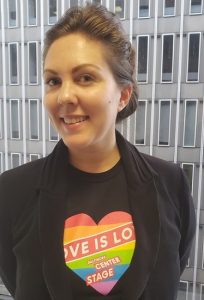1. What do you do as an Arts Education Coordinator for BOPA?
As the Arts Education coordinator, I get to facilitate the Bright StARTs program, which places teaching artist in out of school time sites for workshops in various artistic disciplines; the Youth Arts Council, a team of BCPS high schoolers, dedicated to the arts; and the Fred Art Prize, a $1000 scholarship for high school-aged Baltimore City residents, which also offers a showing at Artscape. I also get to be involved in various programming with BOPA festivals and events, and act as the BOPA representative for various educational initiatives in Baltimore.
2. Who is a part of the Youth Arts Council? What are the main goals?
The council is comprised of around a dozen Baltimore City High School students. We meet together during the school year to discuss opportunities for teens in Baltimore City. This past year we were active with the Baltimore Arts Education Initiative Steering Committee (run by Arts Everyday), adding students’ voices to the conversation surrounding arts education policy standards in Baltimore. I like to think of them as the bureaucratic warriors in the battle for equitable arts education. The council members are also involved in programming for Light City and Artscape and are given opportunities to hear about internships and meet with city leaders. I hope that every year the council can grow to reflect the agendas of those involved.
3. Why are programs like the nearly three decades-old Bright StARTS Art Program important?
There is blatant inequality with arts education street by street, neighborhood by neighborhood in Baltimore. Programs like Bright StARTs are a way to offer quality arts experiences in locations that aren’t typically able to host them because of monetary limitation.
4. How do professional artists/educators become teaching artists in Bright StARTS?
Follow this link! All of the information about the position is available. We are searching for teaching artists who have experience working with kids in Baltimore City and who recognize arts education as a form of therapy and healing. This is also an amazing opportunity for artists who wish to expand the educational aspect of their practices.
5. Where were you before joining BOPA’s staff?
I spent a year working for Bloomberg School of Public Health doing administrative work for a children’s research study. I learned so much during my time there, and I learned a lot about scope, and what I’m NOT good at. Before that I have been a teaching artist in Baltimore City Public Schools and various non-profits. Working directly with young people and artistic programming is where I belong.
6. Outside of BOPA, are you involved in the city’s arts and cultural scene? If so, how?
Since graduating Goucher College in 2008, I have been active in Baltimore’s exciting theater arts scene. I have collaborated with multiple theater companies including Submersive Productions, Stillpointe Theatre Initiative, Single Carrot Theater and the Baltimore Rock Opera Society as a performer, dancer and director.
7. How can the arts continue to revitalize the city in the future?
I believe that arts education is the most accessible form of character education. Quality arts education is the most practical solution to address the problems of bullying, violence and issues with communication. Plus, practicing art is fun!
